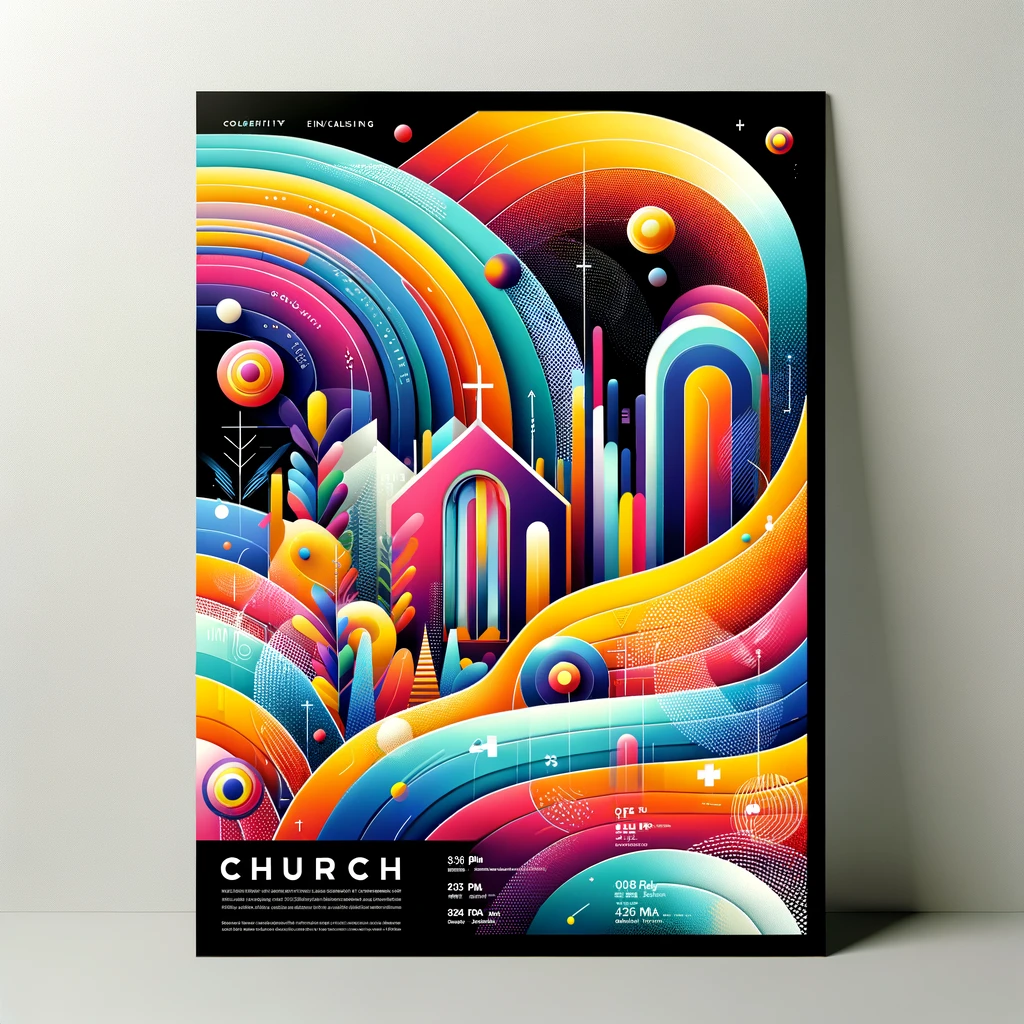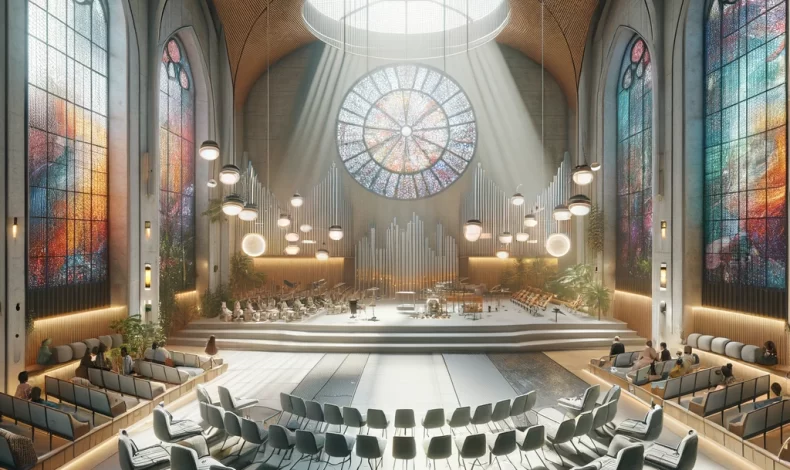The Importance of Balancing Tradition and Innovation in Church Creative Practices
The Importance of Balancing Tradition and Innovation in Church Creative Practices
In the realm of church creative practices, there is a delicate balance that needs to be struck between tradition and innovation. While tradition provides a sense of stability and continuity, innovation allows for growth and relevance in a rapidly changing world. Both elements are crucial for the vitality and effectiveness of a church’s creative endeavors.
Tradition holds a special place in the hearts of many churchgoers. It connects them to their roots, their ancestors, and the rich history of their faith. Traditional practices, such as hymn singing, liturgical rituals, and architectural styles, create a sense of familiarity and comfort. They provide a framework within which the community can gather and worship together. Tradition also serves as a link to the past, reminding believers of the enduring truths and values that have guided their faith for centuries.
However, relying solely on tradition can lead to stagnation and irrelevance. In a rapidly changing world, it is essential for churches to adapt and engage with contemporary culture. This is where innovation comes into play. By embracing new technologies, artistic expressions, and creative approaches, churches can connect with a wider audience and address the needs and concerns of the present generation. Innovation allows for fresh perspectives, creative problem-solving, and the exploration of new ways to communicate the timeless message of the Gospel.
Finding the right balance between tradition and innovation requires careful discernment. It is not about discarding tradition altogether or blindly embracing every new trend. Rather, it is about understanding the core values and principles that underpin tradition and using them as a foundation for innovation. By doing so, churches can maintain a sense of continuity while also remaining relevant and engaging to their congregations.
One way to achieve this balance is through the integration of traditional and contemporary elements in worship services. For example, a church may incorporate traditional hymns into a modern worship band setting, blending the old and the new. This allows for a sense of familiarity while also embracing the musical preferences and cultural expressions of the present generation. Similarly, churches can use technology to enhance traditional practices, such as projecting lyrics on screens or live-streaming services to reach a wider audience.
Another important aspect of balancing tradition and innovation is the involvement of the congregation. By actively engaging the community in the creative process, churches can ensure that their practices reflect the needs and desires of the people they serve. This can be done through surveys, focus groups, or even inviting members to participate in the planning and execution of creative projects. By involving the congregation, churches can create a sense of ownership and investment in the creative practices, fostering a deeper sense of community and unity.
In conclusion, balancing tradition and innovation in church creative practices is of utmost importance. Tradition provides stability and a connection to the past, while innovation allows for growth and relevance in a changing world. By finding the right balance, churches can create worship experiences that are both rooted in tradition and engaging to the present generation. This requires discernment, integration of traditional and contemporary elements, and active involvement of the congregation. Ultimately, the goal is to create a vibrant and dynamic creative culture that honors the past, embraces the present, and looks towards the future.
Church Growth Creativity: Strategies for Balancing Tradition and Innovation
Balancing Tradition and Innovation in Church Creative Practices
Churches have long been known as bastions of tradition, with rituals and practices that have been passed down through generations. However, in today’s rapidly changing world, many churches are finding the need to incorporate innovation and creativity into their worship services and other activities. Balancing tradition and innovation can be a delicate task, but it is essential for churches to remain relevant and engage with their congregations.
One way that churches can balance tradition and innovation is by embracing new technologies. In the past, churches relied heavily on printed materials such as hymnals and bulletins. However, with the rise of digital media, many churches are now using projectors and screens to display song lyrics and sermon notes. This allows for greater flexibility and the ability to easily update content. Additionally, churches can utilize social media platforms to reach a wider audience and engage with members throughout the week.
Another way to balance tradition and innovation is by incorporating new styles of worship music. While traditional hymns have a special place in many churches, there is also a growing desire for contemporary worship songs. By blending both traditional and contemporary music styles, churches can appeal to a wider range of worshippers. This can be done by having a dedicated worship team that includes both traditional and contemporary musicians, or by alternating between traditional and contemporary services.
In addition to music, churches can also incorporate innovative elements into their sermons. This can include using multimedia presentations, such as videos or slideshows, to enhance the message. It can also involve interactive elements, such as small group discussions or Q&A sessions. By incorporating these innovative elements, churches can create a more engaging and dynamic worship experience for their congregations.
However, it is important for churches to approach innovation with caution and respect for tradition. While it is necessary to adapt to the changing times, it is also important to preserve the core values and beliefs that have guided the church for centuries. This can be done by carefully selecting which traditions to preserve and which to modify or let go of. It is also important to involve the congregation in the decision-making process, ensuring that their voices are heard and their concerns are addressed.
Furthermore, churches can balance tradition and innovation by creating spaces that are both familiar and welcoming to all. This can be achieved through thoughtful design and layout, incorporating elements that are traditional, such as stained glass windows or wooden pews, while also incorporating modern amenities and accessibility features. By creating a space that is both traditional and innovative, churches can create an environment that is inviting to both long-time members and newcomers alike.
In conclusion, balancing tradition and innovation in church creative practices is essential for churches to remain relevant and engage with their congregations. By embracing new technologies, incorporating new styles of worship music, and incorporating innovative elements into sermons, churches can create a more engaging and dynamic worship experience. However, it is important to approach innovation with caution and respect for tradition, preserving core values and involving the congregation in decision-making. By creating spaces that are both familiar and welcoming, churches can strike a balance between tradition and innovation, ensuring that they continue to thrive in the modern world.
Enhancing Church Brand Identity through Creative Church Marketing Strategies
Balancing Tradition and Innovation in Church Creative Practices
Enhancing Church Brand Identity through Creative Church Marketing Strategies
In today’s rapidly changing world, churches are faced with the challenge of balancing tradition and innovation in their creative practices. While tradition provides a sense of stability and continuity, innovation allows churches to adapt to the evolving needs and preferences of their congregations. This article explores the importance of finding the right balance between tradition and innovation in church creative practices and how it can enhance church brand identity through creative church marketing strategies.
Tradition plays a significant role in the life of a church. It provides a sense of history and roots, connecting the present congregation to those who came before them. Traditional practices, such as hymn singing, liturgical rituals, and architectural design, create a familiar and comforting environment for worship. These traditions often hold deep meaning for church members and contribute to their sense of belonging and identity within the church community.
However, in order to remain relevant and engage with a diverse and ever-changing congregation, churches must also embrace innovation in their creative practices. Innovation allows churches to explore new ways of worship, incorporate modern technology, and reach out to a wider audience. By embracing innovation, churches can create a dynamic and inclusive environment that appeals to both long-time members and newcomers.
One way churches can balance tradition and innovation is through creative church marketing strategies. Effective marketing strategies can help churches communicate their unique brand identity to the community and attract new members. By combining traditional elements with innovative approaches, churches can create a compelling and authentic brand image that resonates with both current and potential members.
For example, churches can use social media platforms to share their traditional practices and values with a wider audience. By posting videos of traditional hymns or sermons, churches can showcase their rich heritage while also reaching out to younger generations who may be more active on social media. This innovative approach allows churches to bridge the gap between tradition and modernity, appealing to both long-time members and those who are seeking a more contemporary worship experience.
Another way churches can enhance their brand identity is through creative and visually appealing design. By incorporating modern design elements into their branding materials, churches can convey a sense of innovation and relevance. This can be achieved through the use of vibrant colors, contemporary typography, and engaging imagery. By striking a balance between tradition and innovation in their design, churches can create a visual identity that reflects their values and appeals to a wide range of individuals.
Furthermore, churches can also explore innovative ways of worship that incorporate technology. For example, some churches have started using projection screens and multimedia presentations during their services. This allows for a more interactive and visually stimulating worship experience, while still maintaining the core elements of traditional worship. By embracing technology in a thoughtful and intentional manner, churches can enhance their worship practices and engage with a broader audience.
In conclusion, finding the right balance between tradition and innovation is crucial for churches to enhance their brand identity through creative church marketing strategies. By embracing tradition, churches can provide a sense of stability and continuity for their members. At the same time, by embracing innovation, churches can adapt to the changing needs and preferences of their congregation. By combining traditional elements with innovative approaches, churches can create a compelling and authentic brand image that resonates with both current and potential members. Through creative church marketing strategies, churches can effectively communicate their unique brand identity and attract new members, ensuring their continued growth and relevance in today’s ever-changing world.
Exploring Church Space Conversion: Balancing Tradition and Innovation
Balancing Tradition and Innovation in Church Creative Practices
In today’s rapidly changing world, churches are faced with the challenge of balancing tradition and innovation in their creative practices. As the needs and preferences of congregations evolve, church leaders must find ways to honor the rich traditions of the past while embracing new and innovative approaches to worship and community engagement.
One area where this delicate balance is often explored is in the conversion of church spaces. Many churches are finding creative ways to repurpose their buildings to better serve their communities and meet the changing needs of their congregations. However, in doing so, they must carefully consider how to preserve the historical and architectural significance of these sacred spaces while also incorporating modern elements that enhance the worship experience.
One example of this balancing act is the use of technology in church spaces. While some may argue that technology detracts from the traditional worship experience, others see it as a valuable tool for engaging congregants and reaching new audiences. Churches are increasingly incorporating audiovisual equipment, projection screens, and even live streaming capabilities into their worship spaces. These innovations allow for more dynamic and interactive services, while still maintaining the reverence and spirituality that is central to the church experience.
Another area where tradition and innovation intersect is in the design and layout of church spaces. Many churches are reimagining their interiors to create more flexible and multifunctional spaces. This allows for a variety of worship styles and activities to take place within the same building. For example, a church may have a traditional sanctuary for Sunday services, but also have smaller, more intimate spaces for prayer and meditation, as well as larger gathering areas for community events. This blending of traditional and modern elements creates a welcoming and inclusive environment that meets the diverse needs of congregants.
In addition to physical changes, churches are also exploring new ways to incorporate art and creativity into their worship practices. Traditional forms of artistic expression, such as stained glass windows and religious paintings, continue to hold a special place in many churches. However, churches are also embracing contemporary art forms, such as dance, drama, and multimedia presentations, to enhance the worship experience. These creative expressions can help to engage congregants on a deeper level and bring the message of the gospel to life in new and meaningful ways.
While the balance between tradition and innovation can be challenging, it is essential for churches to find a middle ground that allows them to honor their history while also embracing the future. By carefully considering the needs and preferences of their congregations, church leaders can make informed decisions about how to incorporate new and innovative practices into their worship spaces. This balance not only ensures the continued relevance and vitality of the church, but also fosters a sense of connection and belonging among congregants.
In conclusion, balancing tradition and innovation in church creative practices is a complex but necessary task. By finding ways to incorporate new technologies, reimagining church spaces, and embracing artistic expressions, churches can create vibrant and engaging worship experiences that honor the past while embracing the future. This delicate balance allows churches to meet the evolving needs of their congregations and remain relevant and impactful in an ever-changing world.
Fostering Church Community Unity through Creative Church Events and Innovations
Balancing Tradition and Innovation in Church Creative Practices
Fostering Church Community Unity through Creative Church Events and Innovations
In today’s rapidly changing world, churches are faced with the challenge of balancing tradition and innovation in their creative practices. While tradition provides a sense of stability and continuity, innovation allows for growth and adaptation to the needs of the community. Finding the right balance between these two elements is crucial for fostering church community unity.
Tradition plays a significant role in the life of a church. It provides a sense of identity and roots the community in its history. Traditional practices, such as hymn singing and liturgical rituals, have been passed down through generations and hold deep meaning for many churchgoers. These traditions create a sense of familiarity and comfort, allowing individuals to connect with their faith on a personal level.
However, relying solely on tradition can hinder a church’s ability to reach out to new generations and adapt to changing cultural contexts. In order to remain relevant and engage a diverse community, churches must embrace innovation in their creative practices. This can involve incorporating contemporary music, multimedia presentations, and interactive elements into worship services and events.
One way churches can balance tradition and innovation is by creating a space for both in their creative practices. By maintaining traditional elements while also introducing innovative ideas, churches can cater to the needs and preferences of different generations within their community. This can be achieved through a careful selection of music, incorporating both traditional hymns and contemporary worship songs, or by incorporating multimedia elements into traditional liturgical rituals.
Another way to foster unity within the church community is by involving members in the creative process. By encouraging participation and collaboration, churches can create a sense of ownership and belonging among their members. This can be done through creative workshops, where individuals can contribute their ideas and talents to the development of church events and initiatives.
Furthermore, churches can also foster unity by organizing creative church events that bring the community together. These events can range from art exhibitions and concerts to community service projects and outreach programs. By providing opportunities for individuals to express their creativity and serve others, churches can create a sense of purpose and unity within their community.
It is important to note that balancing tradition and innovation is an ongoing process that requires open communication and flexibility. Church leaders and members must be willing to listen to one another’s perspectives and be open to change. By creating a culture of collaboration and respect, churches can navigate the tension between tradition and innovation and find creative solutions that benefit the entire community.
In conclusion, balancing tradition and innovation in church creative practices is essential for fostering church community unity. By creating a space for both traditional and innovative elements, involving members in the creative process, and organizing creative church events, churches can cater to the needs of different generations and create a sense of belonging and purpose within their community. It is through this delicate balance that churches can thrive and continue to be a source of inspiration and guidance for their members.








